
Creating a Recorded Legacy: Traugott, Järvi and the Deutsche Kammerphilharmonie Bremen
Making recordings has come a long way since the days of cutting
and splicing.
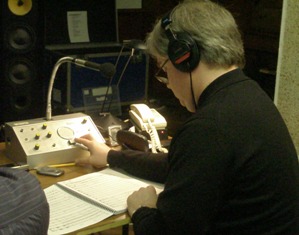
Today, thanks to digital processing, you can do just about anything, says recording producer Philip Traugott. “You can make edits almost anywhere you want. The problem is where do you stop?”
Traugott, former senior producer for BMG Classics, now a busy free lancer based in New York, tries very hard to achieve “a balance between getting as much accuracy in detail as the artist is going to want, and what was the goal after all, which is to have something which really feels like a musical performance.”
How that is done is “sometimes a messy process,” he said. “It’s difficult, complex, trying, tiring, exasperating, hilarious and everything in between.”
This was evident during one of Traugott’s recording sessions
in April with the Deutsche Kammerphilharmonie Bremen at the Funkhaus Nalepastrasse
in Berlin. Led by music director Paavo
Järvi, the Kammerphilharmonie spent three days (17 hours) recording Schumann’s
Symphony No. 1 (“Spring”) with Traugott and a team of engineers from Polyhymnia
(independent recording company based in The Netherlands). It will be paired with Schumann’s Symphony
No. 3 (“Rhenish”) recorded at the site in November, as the first installment of
a complete cycle of Schumann symphonies for Sony.
Working with Traugott were engineers
Jean-Marie Geijsen and Dirk Fischer of Polyhymnia.
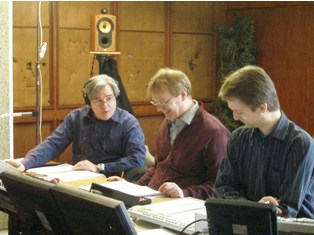
Järvi and Traugott are old friends, though they did not
begin recording together until 2004, when Traugott produced Beethoven's Piano Concertos No. 3 and 5 with pianist Ikuyo Nakamichi and the Kammerphilharmonie Bremen for BMG Japan. This was followed immediately by the complete Beethoven symphonies for BMG (now Sony). Their Beethoven cycle, also recorded at the Funkhaus Berlin, continues to receive high praise and has become the orchestra's calling card around the world.
Located on the banks of the Spree River in southeast Berlin,
the Funkhaus Nalepastrasse is a relic of the Soviet era, dating from the 1950s. Former home of East German Radio, it is a
handsome complex, designed by architect Franz Ehrlich in Bauhaus style. It fell into neglect after the fall of
Communism, but is gradually being revitalized.
The studio building houses the Grossen Sendesaal (“large broadcasting hall”), a prime recording venue
that has remained in constant use because of its superior acoustics. Many well known artists and ensembles have
recorded there, including Daniel Barenboim and the Staatskapelle Berlin, who recorded
their Beethoven symphony cycle there, and popular artists like Sting.
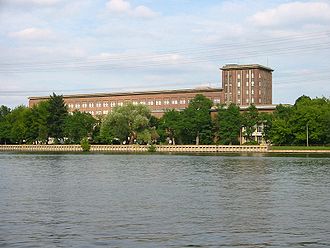
The control room used by Traugott was drab and dilapidated,
having been called into service after new owners of the Funkhaus dismantled the former
control room. The engineers prepared
it acoustically by installing movable, felt-covered panels and a curtain across
one wall. There was no window looking
into the recording hall, but TV monitors provided visual contact with Järvi and
the orchestra.
The recording hall itself is quite handsome, with half
columns at the sides, an organ at one end (in need of repair) and seating for
over 200 people.
The musicians sat in a
tiered pit several steps lower than the main floor. Traugott communicated with Järvi and the musicians with a microphone and headphones (he also had cell phone contact with Järvi).
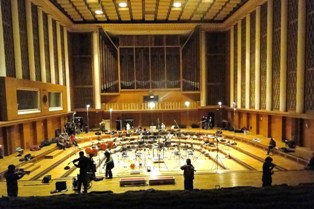
A score and a notebook sat on the table
before him, along with a picture of Robert Schumann. Geijsen and Fischer had their own scores and
manned the sound board and computer, respectively. Traugott used a metronome to keep tempos
precise between takes.
There is an enormous amount of effort and artistry in what Traugott does. “It’s not just a technical operation,” he said. “There are many musical and artistic decisions I have to make to ensure that it remains a musical entity. Otherwise, you have things which are technically correct, if not perfect, but boring. You have succeeded on one level, but not in keeping the performance mode going.”
Traugott, who has produced for Zubin Mehta, Andre Previn, Sir Neville Marriner, Christoph Eschenbach, Leonard Slatkin and the London, Houston and St. Louis Symphonies, among many others, plans recording sessions strategically. The process consists of long and short “takes,” smaller “patches,” complete run-throughs and multiple combinations thereof. A “take” is a recording “with any of a number of goals,” he said (e.g. balances, ensemble, articulation, intonation). “Patches” are focused on a particular issue, which can be as small as correcting a note. He speaks in a calm baritone, addressing the musicians with “please” and “thank you” and complimenting them on their work.
Traugott “mixes up” the process, he said, “because I find
that it’s very important to keep everyone on their toes. I’m constantly going back and forth between
longer and shorter takes and mixing it up so the orchestra never knows what
we’re going to do next.” This is a psychological
tack, too. “If we’ve done a certain
amount of work and not yet accomplished the immediate goal, I’ll stop the orchestra. I’ll hold them back until we do and then finally let them
go. They almost explode out of the gate. Then I have a real performance on my hands.”
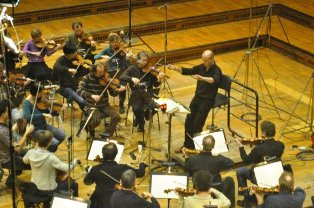
Staying in performance mode is THE challenge in the recording studio. “When I first started out, I found that I might have things which were correct from patches, but often they didn’t have the same kind of spirit and energy, the same tempo or dynamic.” To avoid that pitfall, especially if he’s in a longer symphonic section, he will sometimes rehearse several things at once to use the time efficiently. “I will alert Paavo and the orchestra to what the issues are, suggest some possible solutions, then run a take that passes through all of them. They will play it pretty much the way it was played in the longer context, because they have just been through it.”
In recording vernacular, passages where the composer wrote identical music are called “clones.” Traugott may not spend as much time on a recapitulation, he said, because if it doesn’t go well, he could use a clone from the exposition to save session time for other pressing issues. However, he doesn’t like to do this repeatedly. “If you hear a certain term or phrase exactly the same way three times, it’s not a performance anymore.” He likes to have at least two good performances he can use three times. “The trick may be to use the first time as the third and the second a different way, so that by the third time, people have forgotten what the first was like.”
Another technique of Traugott’s is rehearsing “backwards.” “I find that if you always work from beginning to end, an orchestra can begin to feel like they have pages and pages to go. If I’m in a session, particularly a morning session, and I know the orchestra is at its best, I’ll get the hardest stuff done first.” The “hardest stuff” means transitions and passages where tempos and textures change and the music grows more complex. But again, it has to work musically. “The point is not to just go from measure one to the end 10 times until you get it right.”
To “practice the feeling of something,” the Kammerphilharmonie musicians will sometimes sing their parts. This can be a startling experience for a listener, as when they broke into the love theme from the first movement of the “Spring” Symphony during one of their Schumann sessions at the Funkhaus. This is something that orchestras rarely do, Traugott said.
Production requires a lot of patience.
“With artists, you need it,” he said, having
worked with many of today’s top artists, including Renee Fleming, Peter Serkin,
Pinchas Zukerman, Itzhak Perlman and Thomas Hampson.
“There are times when there’s tension, which is natural if you’re going
to work with relentless high standards and you are dealing with music that is so important and personal to us.
Sometimes that makes for some heated discussions. In the case of Paavo
and me, we find that we work through them and ultimately get as close to the results we want as humanly possible. We have always left the sessions
on the best of terms.”
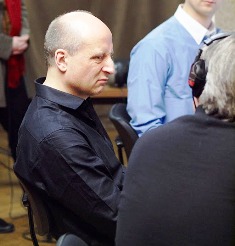
Traugott is the time keeper for the sessions. “I stick very closely and exactly to when breaks are going to be and when the session is over. Paavo, who is so focused on the music and performance, would love to just keep on going. I’m the lucky person who has to tell him that he has to stop, on behalf of the orchestra. If the session has a break at 4 p.m., they’re getting a break at 4 p.m., not 4:10 or 4:03. If they give us until 6 o’clock, we stop at 6. Only if we’re in a dire situation, will we ask them to give us more and usually they say yes.” (The Deutsche Kammerphilharmonie Bremen is a proprietary ensemble owned and operated by its members.)
Often during the sessions, the Kammerphilharmonie musicians
crowded into the control room during their breaks to listen to and comment on
previous takes. Everyone has a stake in
the recording’s success so it is “very much a democratic process,” said
Traugott. “Like Paavo, I push the
orchestra to its limits in terms of re-doing things and I want them to give 100 percent. The orchestra really wants to do this as well. There’s respect and
trust on both sides.”
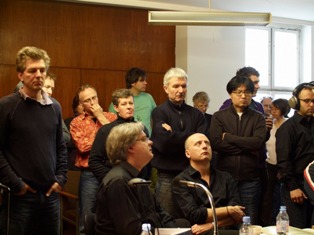
The way the orchestra and Järvi discuss things and work out interpretive details in recording sessions “is highly unusual,” said Traugott. “It’s literally a creative process at work and things evolve constantly. There are levels of complexity and complication which come about as a result of working with this kind of intensity which many artists never even begin to touch.”
For Traugott, who is also a violinist and conductor, the trajectory of a CD is about one month. After the recording sessions, he does the first edit back home in New York. “I pop the CDs with all the takes on them into a professional CD player. I go through them and mark the times, which is a very lengthy and laborious process. I’ve gotten pretty quick at being able to jump from one place to the other and make comparisons while I still have the previous take fresh in my mind.” He plans to begin working entirely by computer soon. “I’ll be able to bring up all the takes that cover a certain musical excerpt, line them up and literally go from one to the next very, very quickly.”
There are many takes in a session, often very detailed, with very specific aims. Whether it’s intonation, tempo, articulation or timing within a transition, “there’s a take just for that moment,” he said. “I mark my score during the sessions to indicate where we’ve achieved a particular goal.” If it’s something Järvi really liked, Traugott will mark it “PJ.” “I look for those and try to make sure they are really the best. Being a musician myself, I have my own ideas about interpretation, but in the end I’m making the artist’s record, not my own.”
Choosing takes is the first part of the editing process and "really the most crucial one in a way," said Traugott. "Creating the first edit is what will give the performance its overall shape and feel. The rest, although very important as well, is the proverbial icing on the cake, for nuance and accuracy, confirmation that 'God is in the details.' I listen with a fine toothed comb in my ear. I take breaks, of course, but there is a point in the course of a day, whether it's after four hours or seven or eight hours, when I don't care anymore which take is better. Then I know I have to stop."
After the edit plan is complete, Traugott sends the score to the editing engineer, who edits on a computer and returns the first edit on a CD to him by mail, or via a digital download. “I'll make a few tweaks and once I get those done, I send it to the artist, who will listen to it and give me a set of comments.” For the final edit, Traugott goes “back to the drawing board” to see (and hear) what there is and whether it can be changed.
Artist participation in the post-production process has changed drastically over the years, Traugott said. “They have become more particular because they know that if you’ve done enough takes, there probably is a better F-sharp somewhere or a better pianissimo. They know that if you can pop in a note or two, you might be able to get what they’re after. Artists formerly didn’t know you could do these things, so if they got a fairly well edited version, unless they found that it really didn’t represent their artistry or wasn’t technically good enough, they might have no or very few comments. Almost all artists have many more comments today.”
In Järvi’s, case “he will often want to go back to the
studio and tweak the tweaking. He has a
very, very fine ear, and once he hears something, he cannot live with it, and
we must find an alternative to fix it.
He is quite meticulous and adamant about wanting certain results,
and he knows the audio technology so well that in the editing studio you can get it."
For a typical CD, Traugott spends “upwards of two to three weeks” crafting his edit plan. After getting a recording from the engineer, sending it to the artist and making further edits, it usually takes close to a month in consecutive days. “That’s actually a very long time,” he added. “When I started at BMG in 1989, I was able to do a whole record in five days. There were less takes -- a different standard perhaps -- less meticulous in its expectations. We were more in the analog era where you had to cut tape with a razor blade. You couldn’t do any of this fancy digital editing where if it works acoustically, you can make an edit anywhere.”
The purpose of recording is not only to make money, but to leave
a recorded legacy, “an historic document,” Traugott calls it. With sales of classical recordings nowhere
near the cost of making them, this is something orchestras “are waking up to,”
he said. “That’s why many orchestras
have revised their own electronic media contracts, to ensure a recorded legacy.”
For Traugott and Järvi, that means striving for an “ideal performance,” one that is as technically perfect as possible, but also “bounces off the score page, something that catches you and moves you musically,” Traugott said.
“The way Paavo and I have of working together is for me to
kind of take care of one layer, to get the orchestra into a white hot pitch in
order to be able to perform the next take with as many of the accuracies we’re
looking for as possible. Then it's up to Paavo and
the orchestra to deliver a real performance.
That’s the crucial point where he takes over from what I’m doing and is able to create great performances over and over again."
“What we’re creating in the studio is kind of larger than
life. It’s a bit more intense. It’s slightly exaggerated in order to
sometimes underline the musical points and gestures we think the composer
intended in the score. We’re trying to
get the leaves, the branches, the trees AND the forest, all of these various layers so that the listener who purchases the recording can enjoy it on many levels and on many occasions.”
Photos by Mary Ellyn Hutton and Jean-Marie Geijsen.
See also "An Ideal 'Marriage'" on this site.